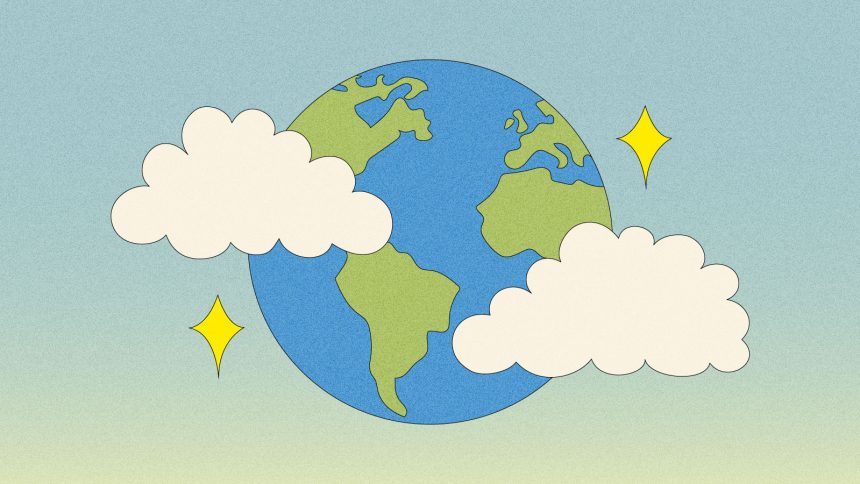“`html
The spotlight
If we get it right, the pace of life is more humane. Time that had been spent dealing with health- and flood-insurance paperwork, advocating for renewable energy, being stuck in traffic, and otherwise butting up against outdated and broken systems, is now used to grow food, prepare for extreme weather events, and care for each other. All streets, not just those in wealthier areas, are lined with trees (including fruit and nut trees), providing shade and beauty and photosynthesis (and snacks). Rain gardens and bioswales line streets, ready to absorb and divert storm waters. We linger outside, in parks and on sidewalks, with friends and neighbors. We have time to make meals at home or consume them at a cafe. “To-go” is uncommon; instead, we meet eyes as we chew. We know plastic recycling is mostly bullshit and have abandoned disposables — instead we (gasp!) wash the dishes. No longer frenzied with meaningless to-dos, we find ease amid the generational work of making our planet livable. As we spend more time outside, our appreciation for nature grows with immersion, inspiring ever more creative adaptations to our changed climate. Biophilia and biomimicry flourish in a virtuous cycle with the thriving of biodiversity. We are unrushed — chill, even. — a DOUBLE drabble, thieved from the final chapter of What If We Get It Right? By Ayana Elizabeth Johnson
The spotlight
Occasionally, when I’m reading an evocative book or article or other piece of literature, I’ll catch myself staring out the window, having looked up from the page involuntarily to daydream. Sure, it could be a sign of a short attention span (thanks, TikTok), but as a writer myself, I actually consider this to be one of the greatest effects a piece of writing can have. Because it’s not that my mind has wandered to unrelated topics — it’s that whatever I’m reading has inspired me in some way that sent my brain off to pause, process, and dream. This happened to me repeatedly with What If We Get It Right?, a new book by marine biologist and climate policy expert Ayana Elizabeth Johnson (in conversation with a couple dozen other leading voices across the climate spectrum, including Bill McKibben, Rhiana Gunn-Wright, Adam McKay, and Leah Penniman). The book focuses on solutions, as well as visions of the world we could have if we implement them — and the importance of holding up those visions as something to work toward. “These pages conjure a thriving (and quite different) world, and show us that it’s worth the effort — the overhaul — to get there, together,” Johnson writes in the book’s introduction. On Monday, I got to hear Johnson share some of her insights on the book, climate solutions, our political moment, and hope, at a Climate Week event put on by Grist, Mother Jones, Rewiring America, and the Tishman Environment & Design Center at the New School. The event was all about envisioning a better future. First, multidisciplinary artist Aisha Shillingford led us through a visioning exercise in which we traveled to the year 2075, witnessed an era dubbed “the Flourissance,” and returned with an artifact. (If you want to try a little visioning yourself, you might remember that Shillingford walked us through a similar exercise last year. You can do this at home!) Then Johnson sat down in conversation with voting rights activist and former Georgia state Representative Stacey Abrams, who is now senior counsel at the electrification nonprofit Rewiring America, among many other things. You may not be able to tell in this photo, but at this moment, Johnson and Abrams had, in fact, burst into a spontaneous singalong — to Prince’s “7,” the first track on the “Anti-Apocalypse Mixtape” that Johnson includes at the end of the book. Claire Elise Thompson During the conversation, the two leaders discussed some of their practical visions for what we must do next to fix the climate crisis. They talked about the proliferation of climate tech, like heat pumps, and the wonderful synergies of when solutions that are good for the planet also make people’s lives better. And they confessed that they share a dislike for hope as a concept (something that Johnson makes clear in the book). “We don’t get to give up on life on Earth. I don’t need hope — I need an action item,” Johnson said. Rather than hope or optimism, they spoke about holding up tenacity and determination as the mindsets we need to address the climate crisis. “My shorthand is, I think the glass is half full. It’s probably poisoned, though,” Abrams said, and described herself as “an ameliorist” — one who’s dedicated to making things better. Before the event, Johnson and I spoke briefly about her approach to writing What If We Get It Right?, the power of manifesting, and some of the action items that are next on her horizon, including an exciting, and extremely unconventional, book tour. Our conversation has been edited and condensed for clarity. (Also. Just as we were parting ways after our interview, as she was getting ready to head onstage for the event, Johnson called after me, “Claire! I love your drabbles!” One of the best moments of my professional life, period.) Q. I really strongly resonated with something you wrote in the book’s introduction: “I created this book because it’s what I’ve needed to read.” Could you talk a bit about that need that you felt, and the gap that this book fills? A. There’s a lot of apocalyptic stuff out there in pop culture — whether that’s out of Hollywood or the way the news just covers climate disasters, if at all. And I just kept thinking, we have the solutions we need. We just need to implement them. Why is no one showing us that it’s worth the effort? And so that’s what this book is: me making the case that it’s worth the effort to get this as right as possible, even knowing it won’t be a perfect world. It’ll be a better world. Q. Why do you think it’s important to imagine the future? Not just forecast, but actually dream of the future? A. I’ve been asked this question a lot of times — something different is coming to mind right now, which is, that’s just the way I do things. No one was like, “You should do a climate variety show in four different cities with all the famous acquaintances you can wrangle and a dance-off and puppets and magic tricks and game shows.” No one was like, “This is what a book tour should be.” But like, why not? Creating this book and envisioning the tour has just been another exercise in, there’s really not as many rules as we think there are. You just do the thing. You dream the thing up, and then you do the thing. And we could do the same with climate that we could do with creating a book or piece of art — we could just create the future that we want to live in, create the world that we want to live in. People use the term a lot, “manifesting,” right? Or “words become things,” or all of that. It starts somewhere. You dream it up and then, as much as you can, make it real in the world. There’s a sense in which my whole life is a case study in that. Because there’s no reason why some Black girl from Brooklyn should actually become a marine biologist because she said it out loud when she was 5 — a lot of people say that out loud when they’re 5. But there’s something about the tenacity of it. I’ve always been enamored with this sense of possibility. But in a sort of boring, realistic way. I wasn’t good with my imagination, per se — I wanted an imaginary friend and I couldn’t quite muster it. You know, I’ve always been very, very grounded in the real world. And I think maybe that’s helpful. My dreams are just big enough to be achievable. So I think it’s only natural that I apply that to climate. Like, why would we not try to do the biggest best thing we possibly can? The sort of more standard answer, the one that I give in the book, is…
“`






